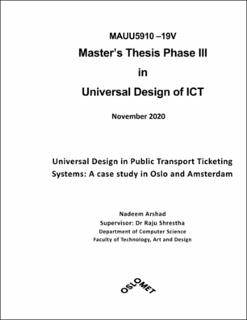| dc.description.abstract | Just like the swift development of ICTs has revolutionized every sector, it has also changed how public transport systems are recognized, and mobilities are performed. The progression has now reached the point where public transport services are ensured to be accessible as far as possible to everyone. One of those public transport services includes the ‘ticketing system’ which mainly constitutes of various communication devices, known as ticketing machines, smart cards, websites of public transport companies and mobile ticketing apps.
These different forms of ticketing system are an essential part of every public transport system and are used by people to get tickets for their journey. Many people, especially those with disabilities are not able to participate in various activities happening in the society simply because the environment, policies and various technologies are not designed to be easily understood and used by them.
Today, when we are striving to adopt universal design solution with built-in adaptability, affinity and capability to accommodate people with diverse capabilities; it is essential to know that whether we are close to achieving this goal of ‘design for all’ and ‘accessible design’. In terms of this, this research is concerned to evaluate the current design and performance of ticketing system from user’s perspective and to find what features of the ticketing system can be improved to make them adapt to user needs.
By design and performance, it means to find that whether the ticketing machines, websites and mobile ticketing applications are fulfilling the needs of everyone. For instance, how people find them in terms of interactivity, interface and navigation. The research also includes finding which of the ticket purchasing method is most preferred by people and why.
Furthermore, this research is directed at two cities of two countries: Oslo and Amsterdam in order to conduct a comparative study on the ticketing system of the public transport sector of these cities. The reason for selecting Oslo and Amsterdam is that: Oslo is the place where I study, and Amsterdam is my home city. Therefore, I have used the ticketing system of both cities and my observations and experience during my daily trips in public transport have inspired me to work on this case study.
Using qualitative study approach, i.e. survey, I evaluated the ticketing system of both cities and found that people in both cities preferred to purchase tickets through the mobile application. However, there was a difference in their least preferred ticketing system. People in Oslo least preferred to purchase tickets through the website while people in Amsterdam least preferred ticketing machine. The reason behind the least preference was found that people were not satisfied with some of the features. The result was further confirmed by Pearson’s correlation test, which concluded that being satisfied or less satisfied with any of the feature is associated with the overall experience of people with that ticketing system | en_US |
